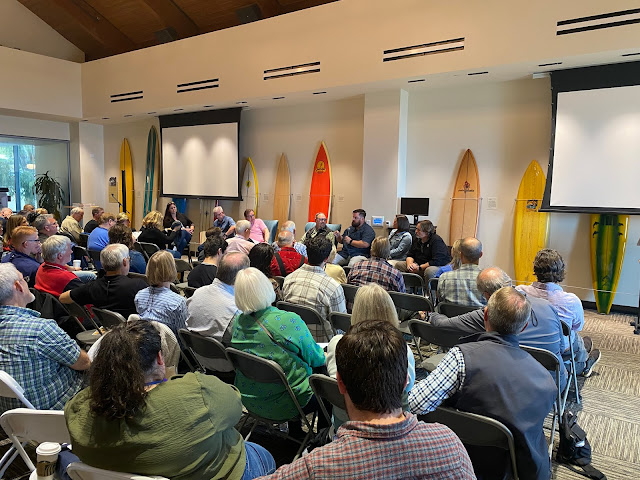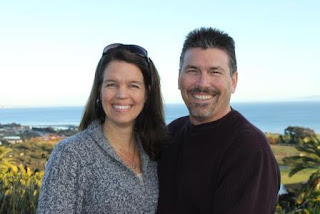Reimagining Church in a Changed World
Most North American churches are in crisis mode. Decline. Division. Lack of direction. Even closure. These are the realities you likely know all too well. It’s old news.
In response to these negative trends, I typically hear one of two lines of thought. The first just involves doing what churches already do, only better. Welcome people more warmly. Lead better worship. Be more transparent. Preach more effectively. Make your facilities more inviting. Serve nicer coffee. Have snazzier kids’ classes. Use social media more successfully. The list goes on and on.

Standing-room only crowd for our workshop at the 2023 Harbor Lectures
This set of strategies stems from the reality that most church leaders have a church-shaped mission. In other words, they know how to do one thing: Sunday morning worship. And since that is what churches do, that must be the tool to turn things around. The mission must fit church as they know it.
The second line of thought is less optimistic. It embraces decline as inevitable and expresses the belief that there is little to be done given the times in which we live. The church’s sole mission, or so the thinking goes, is to hang on and keep doing church.
In this strategy—if it actually is a strategy—death is viewed as a necessary precursor to life. There’s a fatalistic bent here, especially when every change to make a church “healthier” further reduces the number of church-goers. Those who hold to this way of thinking console themselves with thoughts like these: “The path is hard. We must be faithful. Surely God will reward us in the end.”
During this year’s Harbor Lectures at Pepperdine University, I had the privilege of co-leading a workshop on “Reimagining Church for a Changed World.” Tod Vogt, executive director of Mission Alive, was my co-host. Our goal was to help folks picture new ways of envisioning church in our world today. We led a panel of five church planters and church workers who all have experience with building Christian community in ways that aren’t dependent solely on inviting people to worship gatherings.
What strategies did we suggest? How did this panel propose anything different from the tactics commonly found in churches today?
The essence of our thinking is that we need a mission-shaped church, not a church-shaped mission. For far too many Christian communities, Christian life has been reduced to a Sunday morning gathering for one hour per week followed by 167 hours of solo Christian living. Nearly every strategy we hear centers on ways of sending people out to invite their non-church-going friends into a Sunday morning church service. That is all they can imagine.
The reality is that non-church-goers generally have zero interest in walking through the doors of any church service. No matter how well you invite, preach, worship, serve coffee, provide childcare, and so on, they believe church as it exists is not for them. For about seventy percent of people in the US, nothing will get them through the doors of a church building and into a worship service. Yet churches seem unable to picture any other way of doing things.
What Tod and I proposed along with our panelists is to take church beyond our limited imaginings and into places where non-church-goers are. Tod and I both trace our roots back to the Abilene Christian University missions department in the early 1990s. We are both trained as missionaries and we believe that North American churches should also begin to think and act like missionary people.
What might this look like? It will mean that small groups of pioneering Christians will leave their church buildings and enter spaces where they are outnumbered by non-church-goers. This could mean spaces they create or existing ones they join. Ideas are numerous: moms-day-out gatherings, neighborhood dinner clubs, board-game groups, anxiety support meetings, etc. What will differ about these mission-shaped groups is the goal. Here, the aim is not to eventually invite people to Sunday morning church. Instead, the goal is to form Christian community in the middle of these gatherings.
Imagine the example of an English-language-learners’ support group for women immigrants led by a few Christian women. If this gathering meets a felt need and if some immigrant women find these meetings useful, then the Christian women might eventually ask the participants if they have prayer needs. They might then create a prayer board that participants can see as they come for each meeting. If prayer is well received, it could lead to conversations that are more openly about faith. The goal here is to create a kind of Christian community around these women—call it a church, if you will. This raises questions of course, but it also opens incredible possibilities for those who can imagine it.
This is just one example of how church can bend to fit mission. And we believe church absolutely should bend to fit mission, with one caveat. I am not suggesting existing churches stop doing church as they know it. Our existing gatherings are meaningful to the many people who attend them each week. And what’s more, I believe that these gatherings will find ways to bless and support the new forms of church as they take shape.
I am deeply excited about the possibilities that lie before us, if only we can reimagine church in our changed world.



Comments